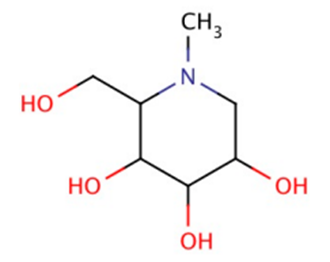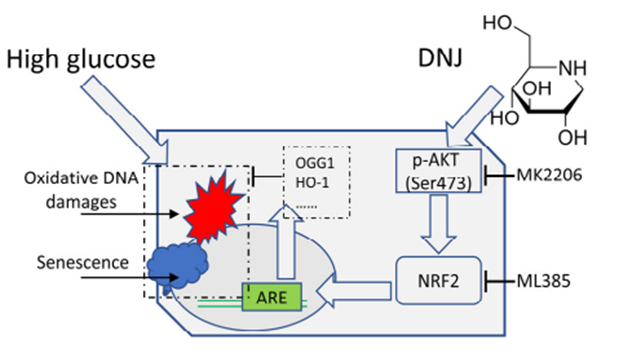1-Deoxynojirimycin (DNJ)
1-Deoxynojirimycin (DNJ) chemical formula C6H13NO4 and molecular weight of 163.17 g/mol, is a type of indigenous alkaloid examined in mulberry leaves, insects, and the culture broth of some microbes as a product of secondary metabolites such as Commelina communis, and bacterial strains including Bacillus and Streptomyces species. As a representative iminopyranose, 1-Deoxynojirimycin exhibits α-glucosidase inhibitor activity along with anti-viral, anti-diabetic, anti-inflammatory, anti-obesity, and antioxidant properties employed for several applications. 1-Deoxynojirimycin lessens the absorption of sugar by inhibiting α-glucosidase and repressing hyperglycemia after meals. It becomes ascertain due to the relatively low content of 1-Deoxynojirimycin in plants and insects for the investigation of 1-Deoxynojirimycin structure or function and reduction in large-scale industrial production.

Figure 1: Chemical structure of 1-Deoxynojirimycin (DNJ)
Biological Prospects of 1-Deoxynojirimycin :Morus alba is a deciduous tree rich in bioactive substances; alkaloids, flavones, sterols, volatile oils, and polysaccharides, retrieved from mulberry fruit and leaves. These native bioactive substances manifest strong physiological effects, including anti-oxidative, anti-diabetic, anti-obesity, and anti-microbial properties which can be added to many traditional remedies due to their capability to handle several diseases.

Figure 2: The mode of 1-Deoxynojirimycin action in the digestive tract
Contemporary research signifies the positive effects of mulberry fruit and leaves on blood sugar levels, the significant bioactive substance analyzed in mulberry is 1-Deoxynojirimycin (DNJ) which is a natural alkaloid ascertained in azasugar and iminopyranose. The study shows that 1-Deoxynojirimycin exhibits antihyperglycemic properties due to the larger affinity of 1-Deoxynojirimycin for glycosidase than oligosaccharides for the impedance of glycosidase joining with oligosaccharide to produce glucose, ultimately resulting in lowering blood sugar levels. Wang et al. declared that through mulberry leaf 1-Deoxynojirimycin therapy patients experiencing heart disease exhibit enhanced blood lipid profile, antioxidant, and anti-inflammatory properties. Gao et al. uncovered in their investigation of the fermentation of mulberry juice that a rise in quercetin and 1-Deoxynojirimycin levels significantly increased the scavenging action of mulberry drinks against free radicals (ABTS+). These earlier researches suggested the antioxidant prospects of 1-Deoxynojirimycin.
1-Deoxynojirimycin promotes Oxidative DNA Damage Repair via stimulating NRF2/OGG1High blood glucose can cause oxidative damage to cells and other health issues such as cell aging and oxidative injuries in addition to diabetes. Zhang et al. discerned in the report that boosting the activities of anti-oxidative enzymes like SOD, catalase, and glutathione peroxidase through mulberry leaf extract bioactive substances 1-Deoxynojirimycin, flavonoids, and polysaccharides, strengthen insulin sensitivity and reduced oxidative damage in a type 2 diabetes rat model. He et al. discovered that a reduction in blood glucose levels and elevated serum SOD activity in a type 2 diabetic rat model can be seen through 1-Deoxynojirimycin therapy. These investigations suggested that 1-Deoxynojirimycin can be implemented to perform various functions in improving diabetes while in response to oxidative stress, anti-oxidative signaling pathways are activated to shield cells. In mammalian cells, the nuclear factor (erythroid-derived like-2)(NRF2) is a master regulator of antioxidative responses, restraining the production of several proteins involved in preserving the balance of the cellular oxidative state. NRF2 is sequestered in the cytoplasm and degraded through the ubiquitin-mediated pathway under normal circumstances, migrating from the cytoplasm into the nucleus in response to an increase in cellular oxidative stress for transcriptional activation of target genes. The majority of NRF2 targets involved in reducing the degree of oxidative stress in cells or anti-inflammation that have been distinguished so far are proteins like NAD(P)H quinone oxidoreductase 1 (NQO1), and heme oxygenase-1 (HO-1). Meanwhile, the proteins targetted by NRF2 in other physiological processes such as DNA damage repair are 53BP1 and 8-oxo guanine DNA glycosylase (OGG1).

Figure 3 : The graphical summary of the involvement of 1-Deoxynojirimycin to incite AKT for vitalization of NRF2 and OGG1 proteins for mitigation of cellular damage caused by high glucose concentration, where ARE represents anti-oxidative response elements
Wang et al. formally published animal research in which they unveiled that chickens' plasma and intestinal tissues evince higher anti-oxidative indices when fed with a meal supplemented with 1-Deoxynojirimycin extracted from mulberry leaves. While utilizing hen gut epithelial cells for cell research, they discovered that 1-Deoxynojirimycin elevated NRF2 mRNA levels for upgraded production of enzymes that scavenge reactive species, such as catalase and SOD. Yu et al. noticed that mulberry extract supplementation elevated the expression of NRF2 protein after exposure to lipopolysaccharide in the liver tissue of inflammation model rats. These investigations unveiled that 1-Deoxynojirimycin can trigger NRF2-mediated anti-oxidative responses besides restricting glycosidase. High concentrations of glucose can trigger the production of reactive oxygen species (ROS), inciting cellular disorders and cell death. In this investigation, Chen, Y., & Wang, J. (2024) examined whether 1-Deoxynojirimycin administration in high-glucose-challenged cells invigorated NRF2 anti-oxidative signaling, preventing oxidative DNA damage and senescence caused by high hyperglycemia by stimulating NRF2. Furthermore, 1-Deoxynojirimycin incited AKT to vitalize NRF2 anti-oxidative signaling yielding overexpression of OGG1 and attenuating cellular damage in high-glucose-challenged cells.
1-Deoxynojirimycin attenuates Oxidative DNA Damage induced by High Blood Sugar High glucose levels elevate the level of oxidative stress in cells, for investigation in this study the researchers examined whether 1-Deoxynojirimycin therapy shields cells from oxidative DNA damage or not. DNA oxidative levels ascended by employing the levels of 8-OHdG, while culturing HUVEC (Human Umbilical Vein Endothelial Cells) in a medium containing 11mmol/L glucose for 24 hours. The cells were then cultivated in a medium containing 11mmol/L or 50mmol/L glucose for a further 48 hours, detecting levels of 8-OHdG by immunofluorescence staining. Figure 4A indicates that high glucose level enhances oxidative DNA damage, where the level of 8-OHdG in cells grown in a medium containing 50mmol/L glucose manifested an increase of 48% in contrast to cells cultured in a medium containing 11mmol/L. The increase in 8-OHdG brought on by 50mmol/L glucose was attenuated by adding 5µmol/L 1-Deoxynojirimycin, alluding that 1-Deoxynojirimycin is involved in the mitigation of oxidative DNA damage due to the OGG1 enzyme. Figure 4B shows the improvement in expression levels with the addition of 1-Deoxynojirimycin, a 30% elevation in OGG1 expression was analyzed in 50mmol/L glucose concentration suggesting that 1-Deoxynojirimycin mitigated oxidative DNA damage by promoting DNA repair mechanism. Since 1-Deoxynojirimycin administration reduced the oxidative DNA damage, employment of the SA-β-gal test to manifests cell senescence linkage to high DNA damage.

Figure 4: (A) Immuno-staining of 8-OHdG (B) Western blotting detection of the expression levels of OGG1 in cells cultured in 11 mmol/L and 50 mmol/L glucose with or without 1-Deoxynojirimycin treatment (C) SA-β-gal staining of senescent cells (D) Western blotting detection of the expression levels of p21 with or without 1-Deoxynojirimycin treatment. Figure 4C suggests the ratio of senescent HUVEC upgraded from 10% in the cells with 11mmol/L glucose to 25% in the cells with 50mmol/L glucose while 1-Deoxynojirimycin addition results in the reduction of senescence ratio to 12% in 50mmol/L glucose exposed cells, cell senescence marker p21 was identified via Western blotting. Figure 4D indicates the expression level of p21 to elevate by 33% in 50mmol/L glucose cultured cells while the addition of 1-Deoxynojirimycin was able to restore the expression of p21, suggesting that 1-Deoxynojirimycin treatment attenuates oxidative DNA damage and cell senescence caused by hyperglycemia.
1-Deoxynojirimycin (DNJ) is a superior α-glucosidase inhibitor in vitro and doesn't inhibit α-amylase which ultimately won't harm the digestive system or impair sugar adsorption. The hypoglycemic activity of 1-Deoxynojirimycin along with mulberry polysaccharide DMP is significantly greater than utilizing either one of them alone, exhibiting extensive research into 1-Deoxynojirimycin extracted from mulberry plants or other sources to be promising in the future. Acknowledging 1-Deoxynojirimycin for its anti-hyperglycemia capability and attenuating cellular oxidative stress while underlying mechanisms are still unclear.














Commentaires